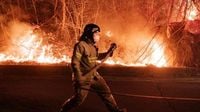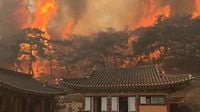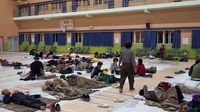South Korea is grappling with the worst forest fires in its history, with the devastation claiming at least 28 lives and forcing the evacuation of approximately 38,000 residents. The fires, which have ravaged around 48,000 hectares of land, are being fueled by strong winds and dry conditions, prompting urgent responses from emergency services.
According to the Korean authorities, the fires began to spread rapidly last Friday, leading to a catastrophic situation that has now been ongoing for over a week. The latest reports indicate that the death toll has risen to 28, with 37 individuals injured. The fires have burned more land than the infamous East Coast fires of 2000, which previously held the record at 23,794 hectares.
In a bid to control the situation, the government has deployed around 40 helicopters and approximately 2,100 firefighters to combat the flames in Uljin and surrounding areas. The Korean Forest Service reported that their efforts had managed to contain about 95% of the main fires, particularly in Uljin, where the situation was most dire. However, officials warn that the risk of the fires reigniting remains high, particularly if wind conditions worsen.
"The high humidity and some of the weather that helped during the night assisted in containing the main fires in Uljin and Andong," stated a representative from the Korean Forest Service. "However, we cannot say that the main fires have been completely extinguished, and if the wind picks up after noon, the fires may spread again in other areas, so we are monitoring the situation closely."
As the fires continue to rage, local communities are facing immense challenges. Survivors have found temporary shelter at Yunjin Elementary School in Andong, as the flames have devastated 27 locations, leaving many residents homeless. The situation has placed significant pressure on South Korean authorities to provide safe havens for those displaced.
The fires have particularly impacted rural villages, where entire communities have been uprooted. Many residents have chosen to remain behind, risking their lives to protect their homes, livestock, and pets from the advancing flames. Local residents have been actively urging firefighters to prioritize areas near their homes in hopes of preventing further destruction.
In addition to the immediate threat to lives and property, the fires pose a significant risk to South Korea's cultural heritage. The southeastern region affected by the fires is home to approximately 4,000 registered national heritage sites. In response, 750 personnel have been allocated to safeguard these cultural treasures from the encroaching flames.
Experts attribute the increasing frequency and severity of forest fires in South Korea to the ongoing impacts of climate change, coupled with the country's mountainous terrain and strong winds. The current situation highlights the urgent need for improved fire management strategies and heightened awareness of climate-related risks.
As the nation continues to battle these unprecedented fires, the government is working tirelessly to coordinate relief efforts and ensure the safety of its citizens. The situation remains fluid, with authorities on high alert for any changes in weather patterns that could exacerbate the fires.
In summary, South Korea is facing a catastrophic environmental disaster as it battles its worst forest fires on record. With the death toll rising and thousands displaced, the country is in a race against time to contain the flames and protect its communities and cultural heritage. The response from emergency services has been commendable, but the ongoing threat of climate change looms large, necessitating a reevaluation of fire management practices and community preparedness.






